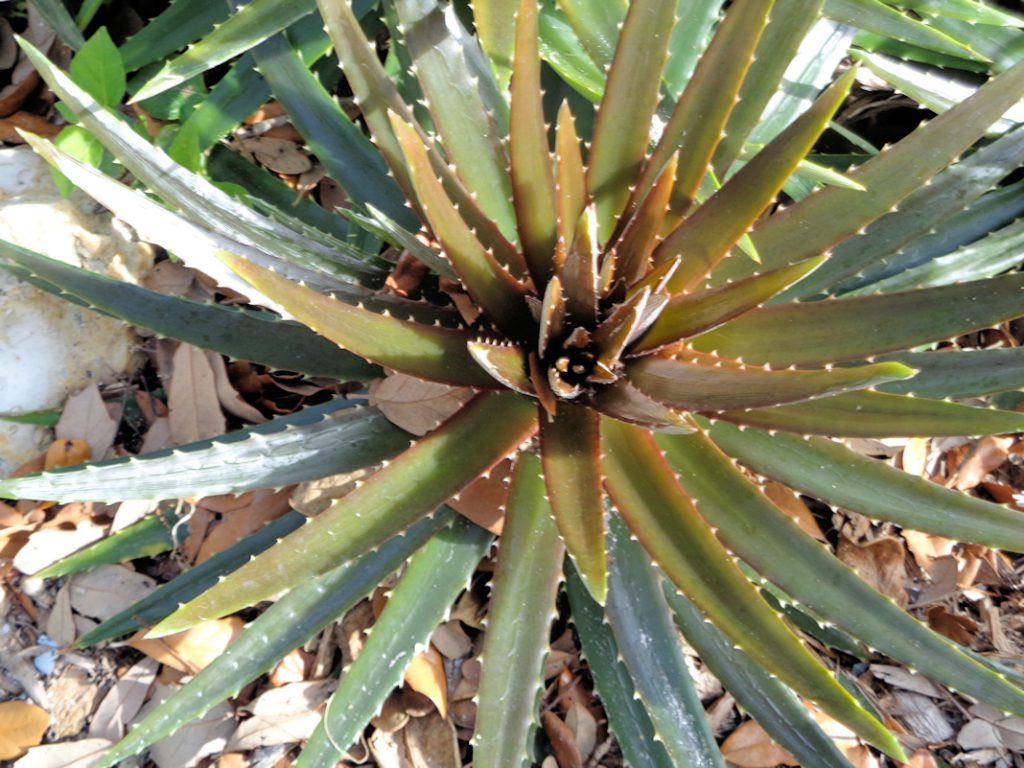
Almost everyone is familiar with bromeliads and the myriad of types, colors and floral displays. There is another bromeliad relative called Dyckia which maintains the bromeliad shape but has characteristics of hardiness and drought-tolerance more in keeping with succulents. They also sport blood-drawing spines and hooks adding to their arid plant characteristics.
Dyckia plants originated from Brazil, Uruguay, Paraguay and Bolivia. In their native environments, Dyckia plants are found in full sun growing mostly on the ground, but some are epiphytic and grow attached to rocks. These native areas have cool winter temperatures placing the Dyckia into the hardy department for our region. They do best with a wet, but well-drained growing season, and a relatively dry dormant season. Succulent in appearance and nature to a degree, Dyckia plants don’t store water in their leaves – they just go dormant.
Plant collectors brought the Dyckia to the gardening world as a unique container plant. In form, this plant is a rosette of narrow leaves armed with very sharp spines and hooks that you need to be careful of. Dyckia lack the typical cup which holds water commonly found in bromeliads. Colorful in nature, Dyckia come with foliage in red, bronze, purple, yellow, green and silver. I recently saw one cultivar called ‘Cherry Coke’ which is dark red in color with leaves up to two feet long. Dyckia typically range from a couple of inches to several feet in width. They produce tall flower spikes with red, orange or yellow flowers attractive to bees and hummingbirds.
Once a bromeliad flowers, it produces offsets and dies. Dyckia do not die in this manner and can flower again. Some do produce offsets which can be used for propagation purposes or allowed to form an exotic groundcover. Some Dyckia propagate themselves where the entire head divides to smaller plants. In either case allow the offset or divisions to get well developed before removing from the mother plant. Seeds set from flower spikes can be used for propagation as well.
Dyckia do great in containers that accommodate their large root system. Use a well-drained potting medium suitable for succulents and an appropriately sized pot. I saw a great display of Dyckia in the landscape at the Berne Davis Botanical Gardens in Fort Myers. These Dyckia made a beautiful tight groundcover with a texture like no other.
Where do you get your own Dyckia? Anywhere that specializes in bromeliads will likely carry Dyckia. Also check local family-run garden centers and on-line sources. The Dyckia is an unique plant that offers something new for your plant palette – just look out for the spines! For more information on all types of succulent-like plants suitable for our area, or to ask a question, please visit https://www.facebook.com/CharlotteMGLifeline/ . Ralph E. Mitchell is the Director/Horticulture Agent for the UF/IFAS Charlotte County Extension Service. He can be reached at 941-764-4344 or ralph.mitchell@charlottecountyfl.gov
Resources:
UF/IFAS Gardening Solutions (2014) Dyckia Characteristics. The University of Florida Extension Service, IFAS.
Booth, C. (2019) Dyckia: A Prickly Pitcairnioideae. https://www.bromeliads.info/all-about-dyckias/ .
World of Succulents (2020) How to Grow and Care for Dyckia https://www.gardeningknowhow.com/houseplants/bromeliad/growing-dyckia-plants.htm
Holmes, K. (2019) Gardening 101: Dyckia. Gardenista. https://www.gardenista.com/posts/gardening-101-dyckia/
 0
0
